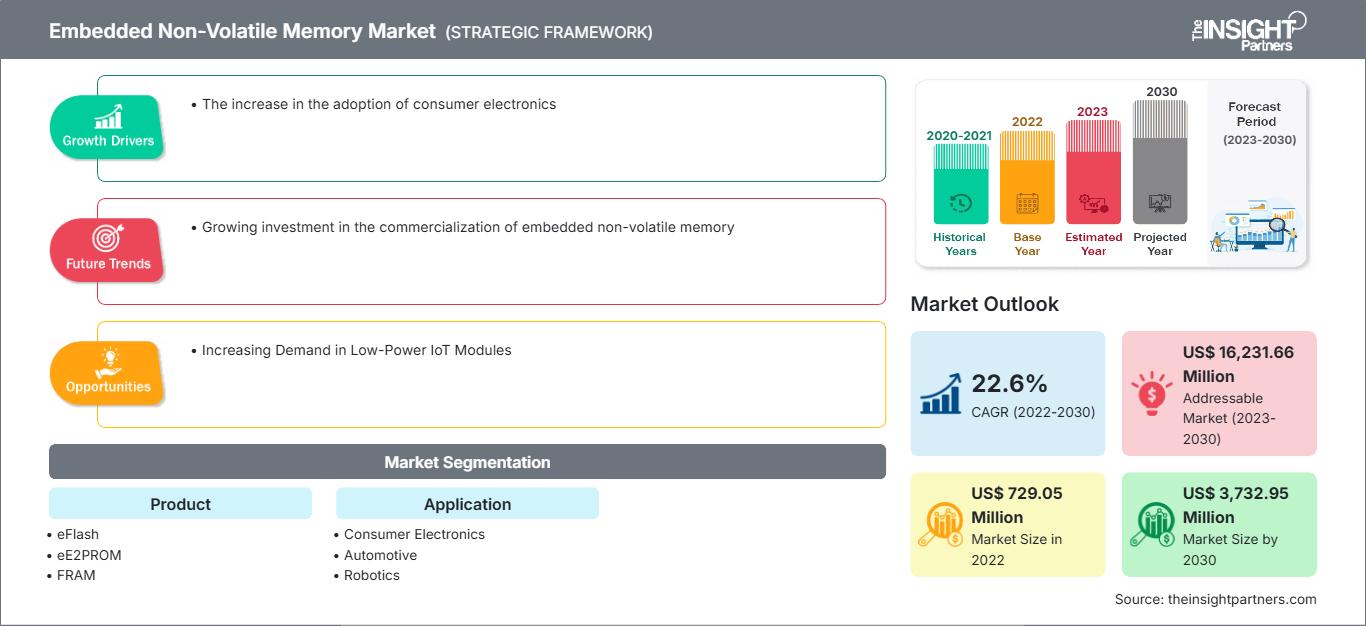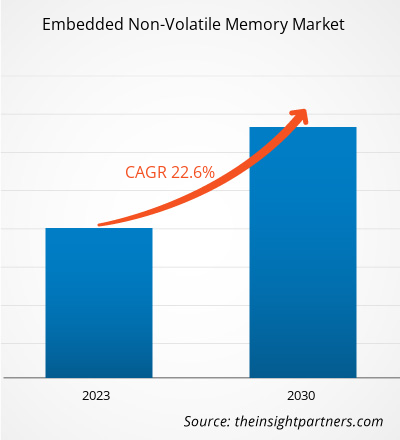嵌入式非易失性存储器市场规模预计将从 2022 年的 7.2905 亿美元增至 2030 年的 37.3295 亿美元。预计该市场在 2022 年至 2030 年期间的复合年增长率将达到 22.6%。消费电子产品的普及和汽车行业的扩张很可能仍将是市场的主要趋势。
嵌入式非易失性存储器市场分析
嵌入式非易失性存储器市场的增长归因于人均 GDP 的增长,以及先进消费电子产品在大众中的普及。先进电子产品在汽车中的应用日益增多,以及联网设备的日益普及,也推动了市场的增长。此外,物联网解决方案的日益普及以及智慧城市项目的蓬勃发展预计将在不久的将来推动嵌入式非易失性存储器市场的发展。
嵌入式非易失性存储器市场概览
嵌入式非易失性存储器 (eNVM) 是一种集成到微控制器和用于数据存储的硬件中的紧凑型芯片。存储的数据用于编程、加密、编码、识别、修改和冗余。非易失性存储器系统包含晶体管,这些晶体管由一层绝缘层包裹的导电材料组成。当微控制器通电时,周围的绝缘层会捕获少量电流,从而使非易失性存储器能够保留其数据。嵌入式非易失性存储器凭借其微小的尺寸和高效率,正在取代传统的独立非易失性存储器。这种存储器技术正在成为基于微控制器的物联网 (IoT) 设备的重要组成部分之一。
自定义此报告以满足您的要求
您将免费获得任何报告的定制,包括本报告的部分内容,或国家级分析、Excel 数据包,以及为初创企业和大学提供超值优惠和折扣
嵌入式非易失性存储器市场: 战略洞察

-
获取本报告的主要市场趋势。这个免费样本将包括数据分析,从市场趋势到估计和预测。
嵌入式非易失性存储器市场驱动因素与机遇
不断发展的汽车行业
现代科技的影响对汽车行业产生了积极的影响。全球数字技术的出现使制造商能够在汽车中实施先进的解决方案。如今,汽车配备了一系列先进的技术,旨在为用户提供更安全、舒适和愉悦的驾驶体验,这增加了汽车行业对嵌入式非易失性存储器的需求。嵌入式非易失性存储器集成到嵌入式系统中,在常规汽车和混合动力汽车中都得到了广泛的应用。这些存储器可帮助汽车用户在车辆系统重启后存储代码和其他数据。嵌入式非易失性存储器用于电动和混合动力汽车中的 ADAS 技术。对电动和混合动力汽车日益增长的需求正在推动市场发展。例如,根据国际能源署 (IEA) 的数据,2022 年电动汽车销量将增加 1000 万辆。全球新售汽车中约有 14% 是电动汽车。全球电动汽车销量的不断增长,推动了汽车制造商对嵌入式非易失性存储器的采用。这些存储器用于在断电情况下存储数据。
消费电子市场蓬勃发展
随着全球消费者可支配收入的不断增长,个人购买力也在不断提升,这进一步促进了消费电子产品的销售。城市化进程的加快和人们生活方式的改变是推动消费电子产品销售的另一个因素。随着消费电子市场的蓬勃发展,对嵌入式非易失性存储器的需求也日益增长,因为它被广泛应用于智能手机、相机、智能手表、电视、智能音箱、平板电脑等多种消费电子产品的微控制器中。它支持微控制器进行数据存储。
嵌入式非易失性存储器市场报告细分分析
有助于得出嵌入式非易失性存储器市场分析的关键细分是产品和应用。
- 基于产品,嵌入式非易失性存储器市场分为 eFlash、eE2PROM、FRAM 等。eFlash 细分市场在 2022 年占据了最大的市场份额。
- 根据应用,市场细分为消费电子、汽车、机器人细分市场和其他。机器人细分市场在 2022 年占据了相当大的市场份额。
嵌入式非易失性存储器市场份额按地域分析
嵌入式非易失性存储器市场报告的地理范围主要分为五个区域:北美、亚太地区、欧洲、中东和非洲以及南非。中美洲。
2022年,北美占据着重要的全球市场份额。该地区嵌入式非易失性存储器采用率的预期增长,可以归功于该地区汽车和消费电子市场销量的增长。美国、加拿大和墨西哥电动汽车的普及率不断提高,将增加对微控制器的需求,这些微控制器被广泛应用于汽车的各个方面,以打造更安全、更智能、更环保的汽车。由于资本增长和汽车出口的增加,该地区的汽车行业正在经历巨大的增长。嵌入式非易失性存储器还支持高级驾驶辅助系统 (ADAS) 和车载信息娱乐 (IVI) 系统的开发,使汽车比以往任何时候都更加智能、互联互通。
嵌入式非易失性存储器市场
The Insight Partners 的分析师已详尽阐述了预测期内影响嵌入式非易失性存储器市场的区域趋势和因素。本节还讨论了北美、欧洲、亚太地区、中东和非洲以及南美和中美洲的嵌入式非易失性存储器市场细分和地域分布。
嵌入式非易失性存储器市场报告范围
| 报告属性 | 细节 |
|---|---|
| 市场规模 2022 | US$ 729.05 Million |
| 市场规模 2030 | US$ 3,732.95 Million |
| 全球复合年增长率 (2022 - 2030) | 22.6% |
| 历史数据 | 2020-2021 |
| 预测期 | 2023-2030 |
| 涵盖的领域 |
By 产品
|
| 覆盖地区和国家 |
北美
|
| 市场领导者和主要公司简介 |
|
嵌入式非易失性存储器市场参与者密度:了解其对业务动态的影响
嵌入式非易失性存储器市场正在快速增长,这得益于终端用户需求的不断增长,而这些需求的驱动因素包括消费者偏好的不断变化、技术进步以及对产品优势的认知度不断提高。随着需求的增长,企业正在扩展其产品线,不断创新以满足消费者需求,并抓住新兴趋势,从而进一步推动市场增长。

- 获取 嵌入式非易失性存储器市场 主要参与者概述
嵌入式非易失性存储器市场新闻及最新发展
嵌入式非易失性存储器市场评估是通过收集一手和二手研究的定性和定量数据进行的,这些数据包括重要的企业出版物、协会数据和数据库。嵌入式非易失性存储器市场的一些发展如下:
- ANAFLASH 是一家位于硅谷的边缘计算智能微控制器开发商,已从明尼苏达大学 (UMN) 获得基于单层多晶硅的嵌入式闪存技术的独家许可。这家 UMN 初创公司目前正致力于将这项经济高效且节能的非易失性存储器技术商业化,该技术现已授权给合作伙伴,主要用于众多电池供电设备,例如医疗可穿戴设备、无线传感器和自主机器人。 (来源:ANAFLASH,新闻稿,2023 年 3 月)意法半导体凭借其在串行 EEPROM 技术方面久经考验的专业知识,推出了市场上首款串行页面 EEPROM。这款全新的 EEPROM 是一款高密度、页面可擦除的 SPI 存储器,具有独特且前所未有的灵活性和性能,同时功耗极低。 (来源:意法半导体,新闻稿,2022 年 6 月)
嵌入式非易失性存储器市场报告覆盖范围和交付成果
《嵌入式非易失性存储器市场规模和预测(2020-2030 年)》报告对市场进行了详细的分析,涵盖以下领域:
- 嵌入式非易失性存储器市场规模以及涵盖范围内所有关键细分市场的全球、区域和国家/地区预测
- 嵌入式非易失性存储器市场趋势以及市场动态,例如驱动因素、限制因素和关键机遇
- 详细的 PEST/波特五力模型和 SWOT 分析
- 嵌入式非易失性存储器市场分析,涵盖关键市场趋势、全球和区域框架、主要参与者、法规和最新市场发展
- 行业格局和竞争分析,涵盖市场集中度、热图分析、知名参与者和最新发展面向嵌入式非易失性存储器市场
- 详细的公司简介
- 历史分析(2 年)、基准年、预测(7 年)及复合年增长率
- PEST和SWOT分析
- 市场规模、价值/数量 - 全球、区域、国家
- 行业和竞争格局
- Excel 数据集
近期报告
相关报告
客户评价
购买理由
- 明智的决策
- 了解市场动态
- 竞争分析
- 客户洞察
- 市场预测
- 风险规避
- 战略规划
- 投资论证
- 识别新兴市场
- 优化营销策略
- 提升运营效率
- 顺应监管趋势






















 获取免费样品 - 嵌入式非易失性存储器市场
获取免费样品 - 嵌入式非易失性存储器市场